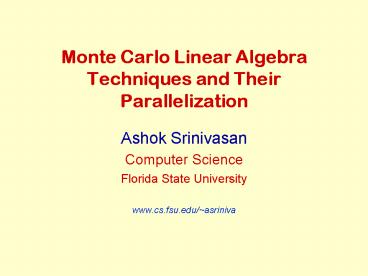Monte Carlo Linear Algebra Techniques and Their Parallelization - PowerPoint PPT Presentation
Title:
Monte Carlo Linear Algebra Techniques and Their Parallelization
Description:
Take a random walk, based on these probabilities. Define random variables Xi ... Each random walk can be used to estimate the kj th component of Cj h ... – PowerPoint PPT presentation
Number of Views:44
Avg rating:3.0/5.0
Title: Monte Carlo Linear Algebra Techniques and Their Parallelization
1
Monte Carlo Linear Algebra Techniques and Their
Parallelization
- Ashok Srinivasan
- Computer Science
- Florida State University
www.cs.fsu.edu/asriniva
2
Outline
- Background
- Monte Carlo Matrix-vector multiplication
- MC linear solvers
- Non-diagonal splitting
- Dense implementation
- Sparse implementation
- Parallelization
- Conclusions and future work
3
Background
- MC linear solvers are old!
- von Neumann and Ulam (1950)
- Were not competitive with deterministic
techniques - Advantages of MC
- Can give approximate solutions fast
- Feasible in applications such as preconditioning,
graph partitioning, information retrieval,
pattern recognition, etc - Can yield selected components fast
- Are very latency tolerant
4
Matrix-vector multiplication
- Compute Cj h, C e R nxn
- Choose probability and weight matrices such that
- Cij PijWij and hi pi wi
- Take a random walk, based on these probabilities
- Define random variables Xi
- X0 w0, and Xi Xi-1 Wki ki-1
- E(Xj dikj) (Cj h)i
- Each random walk can be used to estimate the kj
th component of Cj h - Convergence rate independent of n
pk0
k0
Pk1k0
k1
Pk2k1
k2
kj
Update (Cj h)kj
5
Matrix-vector multiplication ... continued
pk0
- Smj0 Cj h too can be similarly estimated
- Smj0 (BC) jBh will be needed by us
- It can be estimated using probabilities on both
matrices, B and C - Length of random walk is twice that for the
previous case
k0
Pk1k0
k1
Pk2k1
k2
Pk3k2
k3
Update (Cj h)k2j1
k2m1
6
MC linear solvers
- Solve Ax b
- Split A as A N M
- Write the fixed point iteration
- xm1 N-1 Mxm N-1 b Cxm h
- If we choose x0 h, then we get
- xm Smj0 Cj h
- Estimate the above using the Markov chain
technique mentioned earlier
7
Current techniques
- Current techniques
- Choose N a diagonal matrix
- Ensures efficient computation of C
- C is sparse when A is sparse
- Example N Diagonal of A yields the Jacobi
iteration, and the corresponding MC estimate
8
Properties of MC linear solvers
- MC techniques estimate the result of a stationary
iteration - Errors from the iterative process
- Errors from MC
- Reduce the error by
- Variance reduction techniques
- Residual correction
- Choose a better iterative scheme!
9
Non-diagonal splitting
- Observations
- It is possible to construct an efficient MC
technique for specific splittings, even if
explicit construction of C were computationally
expensive - It may be possible to implicitly represent C
sparsely, even if C is not actually sparse
10
Our example
- Choose N to be the diagonal and sub-diagonal of A
d1 s2 d2 sn dn
. . . . . .
N
N-1
- Computing N-1 C is too expensive
- Compute xm Smj0 (N-1 M)j N-1 b instead
11
Computing N-1
- Using O(n) storage and precomputation time, any
element of N-1 can be computed in constant time - Define T(1) 1, T(i1) T(i) si1/di1
- N-1ij
- 0, if i lt j
- 1/di, if i j
- (-1)i-j /dj T(i)/T(j), otherwise
- The entire N-1, if needed, can be computed in
O(n2) time
12
Dense implementation
- Compute N-1 and store in O(n2) space
- Choose probabilities proportional to the weight
of the elements - Use the alias method to sample
- Precomputation time proportional to the number of
elements - Constant time to generate each sample
- Estimate Smj0 (N-1 M)j N-1 b
13
Experimental results
Walk length 2
14
Sparse implementation
- We cannot use O(n2) space or time!
- Sparse implementation for M is simple
- Sparse representation of N-1
- Choose Pij
- 0, if i lt j
- 1/(n-j1) otherwise
- Sampled from the uniform distribution
- Choose Wij N-1ij Pij
- Constant time to determine any Wij
- Minor modifications needed when si 0
15
Parallelization
Proc 2 RNG 2
Proc 3 RNG 3
23.7
23.2
23.6
23.5
- MC is embarrassingly parallel
- Identical algorithms are run independently on
each processor, with the random number sequences
alone being different
16
MPI vs OpenMP on Origin 2000
- Cache misses cause poor performance of the
OpenMP parallelization
17
Conclusions and future work
- Demonstrated that is possible to have effective
MC implementations with non-diagonal splittings
too - Need to extend this to better iterative schemes
- Non-replicated parallelization needs to be
considered































